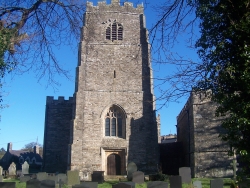
Menai Bridge
Real or mythical, there are several big characters who have played a role in shaping Snowdonia’s history and, by extension, its landscape. Here are just a few…
We all know that Snowdonia‘s geographical landscape was shaped by geological events that took place thousands of years ago.
But the people who have lived in Snowdonia have shaped the region in other ways.
From building hill forts and castles to storytelling and miracles, Snowdonia’s characters – both real and mythical – have a lot to answer for!
Here are eight of Snowdonia’s characters whose presence is still felt in Snowdonia today.

Conwy suspension bridge
1. Thomas Telford
It’s thanks to Thomas Telford that travel to Snowdonia became easier in the 19th century. The renowned engineer was responsible for building what is now the A5 London to Holyhead road, as well as the Menai Suspension Bridge – both of which greatly improved travel between London and Ireland. Telford also built the Conwy Suspension Bridge, one of the first road suspension bridges in the world, and the Waterloo Bridge at Betws-y-Coed.

King Arthur’s Labyrinth
2. King Arthur and Merlin
Although they’re two separate people, King Arthur and Merlin are so much a part of the same stories we think it’s reasonable to treat them as one person! These two characters – and we still don’t know for sure whether they existed or not – are closely tied to Snowdonia. They appear in dozens of stories about the region, including Bardsey being the real Avalon, the warring dragons at Dinas Emrys, the giant on Snowdon and Arthur’s last battle. To find out more about these stories and more, we highly recommend a trip to King Arthur’s Labyrinth in Corris!

Criccieth Castle
3. Llywelyn and Edward
Bloody battles between Edward I of England and Llywelyn ap Gruffudd of Gwynedd for the right to rule Wales are the main reason there are so many beautiful castles to visit in Snowdonia today. The buildings themselves (what’s left of them, anyway) may be beautiful, but their reason for existence is quite the opposite. The medieval castles you can visit in Snowdonia include Caernarfon, Conwy, Harlech, Criccieth, Dolwyddelan and Dolbadarn.

Gelert’s grave
4. David Pritchard
David Pritchard was the landlord of the Goat Inn at Beddgelert in the 1700s. And it’s thanks to him, and a committee of villagers, that the legend of Gelert, the faithful hound killed in error for a crime he didn’t commit, is associated with the village. Very similar stories to the Gelert tale pop up all over the world, and it seems that Pritchard and his committee rewrote the tale so that it took place in this sleepy Snowdonia village, which put Beddgelert very much on the tourism map and ensured a healthy economy for the villagers for centuries to come.

Nant Gwrtheyrn
5. Vortigern/Gwrtheyrn
Vortigern (or Gwrtheyrn as he was known in Wales) was a disgraced Kentish king in the early 5th century who was tricked into betraying his countrymen by Hengist, the leader of the Saxons. Gwrtheyrn ran away to Snowdonia, where his attempts to build a fort were thwarted when the building kept disappearing. A young magician, Emrys Wledig (or Myrddin Emrys, AKA Merlin), told him there was a red dragon and a white dragon (representing Wales and the Saxons, respectively) fighting in a pool beneath the building, so they drained the pool and the dragons continued their battle in the sky – the red dragon being victorious and securing its place on the Welsh flag. Emrys built his fort on the site – Dinas Emrys, at Beddgelert, in case you hadn’t guessed – and Gwrtheyrn fled to the Llyn Peninsula, settling in a place that is now known as Nant Gwrtheyrn. You can visit Nant Gwrtheyrn on day trips to find out more about local folklore and history – but you can also book a place on residential course and learn to speak Welsh like a local!

Portmeirion Village
6. Clough Williams Ellis
Clough Williams-Ellis made a massive contribution to Snowdonia by designing, constructing and renovating so many beautiful buildings in the area – the most famous of his projects being, of course, Portmeirion Village. Clough’s family home was Brondanw, a sprawling estate at Llanfrothen which these days is a tourist attraction renowned for its beautiful gardens. You can see examples of Clough’s architecture all over Snowdonia, including at Penrhyndeudraeth and Aberdaron.

Segontium
7. Agricola
Around 77-78AD Gnaeus Julius Agricola, a Roman general, led campaigns against the Ordovices tribes of North Wales and Anglesey, leaving behind several forts when the Romans eventually moved back out. One such fort was Segontium, on the outskirts of modern Caernarfon; some of its stones were later used in the building of Caernarfon Castle. The ruins of Segontium are now in the management of Cadw, and are open as a tourist attraction. Other Roman remains in the region include Caer Gai, near Bala, and Tomen y Mur, near Trawsfynydd.

St Beuno, Clynnog Fawr
8. St Beuno
St Beuno is patron saint of North Wales. His name will be seen dotted all over the region, but is most concentrated in and around Clynnog Fawr where he founded his monastic cell in the 7th century. This later became a church, and an important stopping point along the pilgrims’ route to Bardsey. Several miracles were attributed to Beuno, including at least two where he reattached the heads of decapitated women, bringing them back to life. The Church of St Beuno in Clynnog Fawr is very much worth a visit, as it hosts an exhibition about the Bardsey pilgrims and is a very beautiful and interesting building. Not far from the church is Beuno’s Well, a spring that is said to have appeared after one of Beuno’s miracles and which is also said to have healing powers.